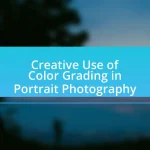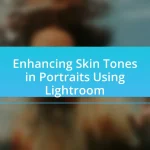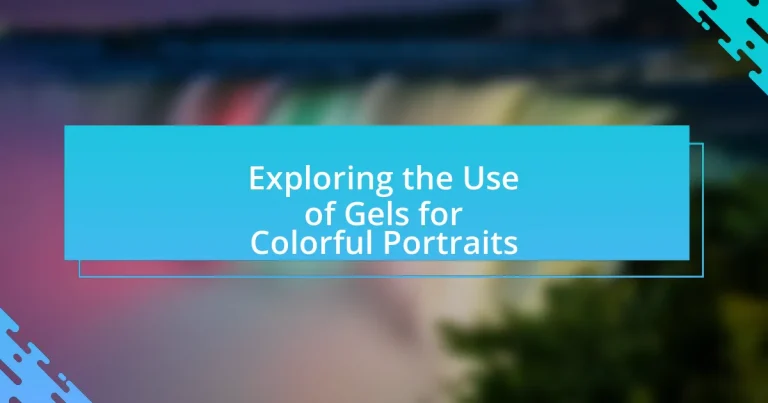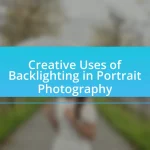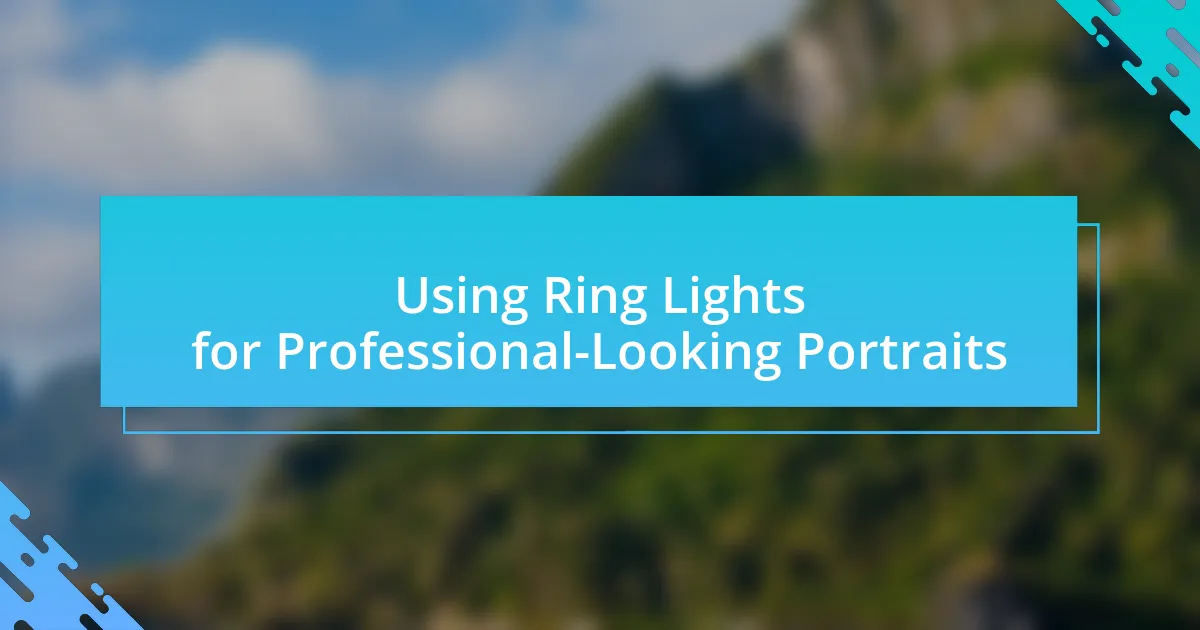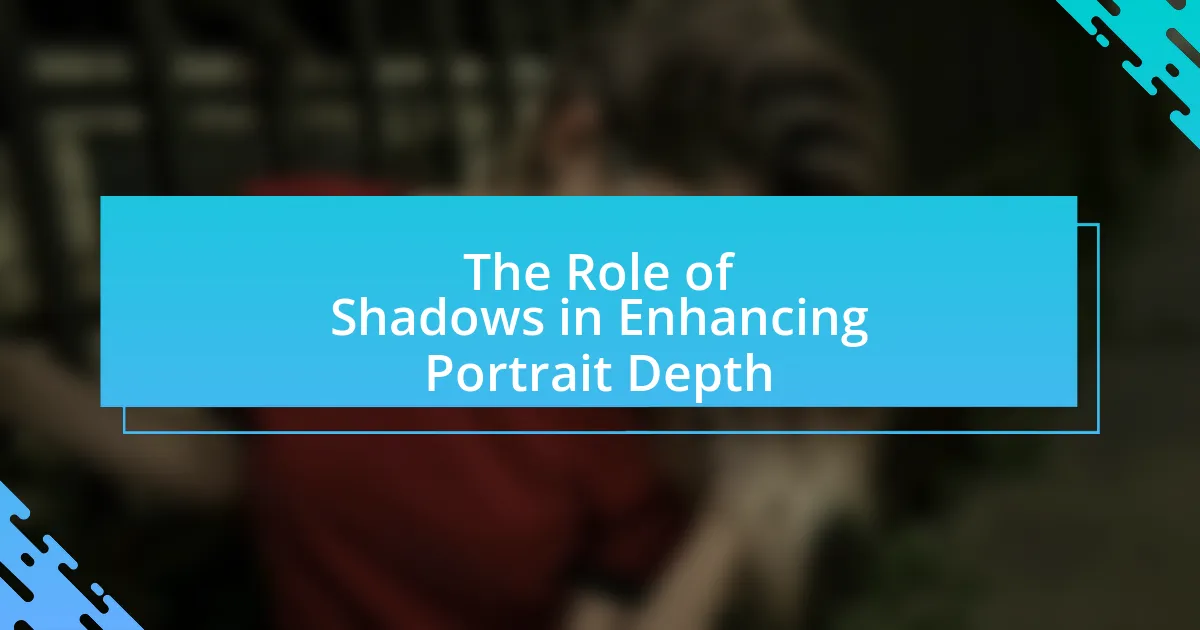The article focuses on the use of gels in portrait photography, detailing their function as colored filters that modify light emitted from flash or continuous light sources. It explores various types of gels, including color correction, diffusion, and creative color gels, and discusses their impact on mood, skin tones, and overall aesthetics in portraits. Key techniques for applying gels, such as layering, strategic lighting placement, and troubleshooting common issues, are also covered, along with best practices for achieving consistent and visually appealing results. Additionally, the article highlights resources for further learning about the effective use of gels in photography.
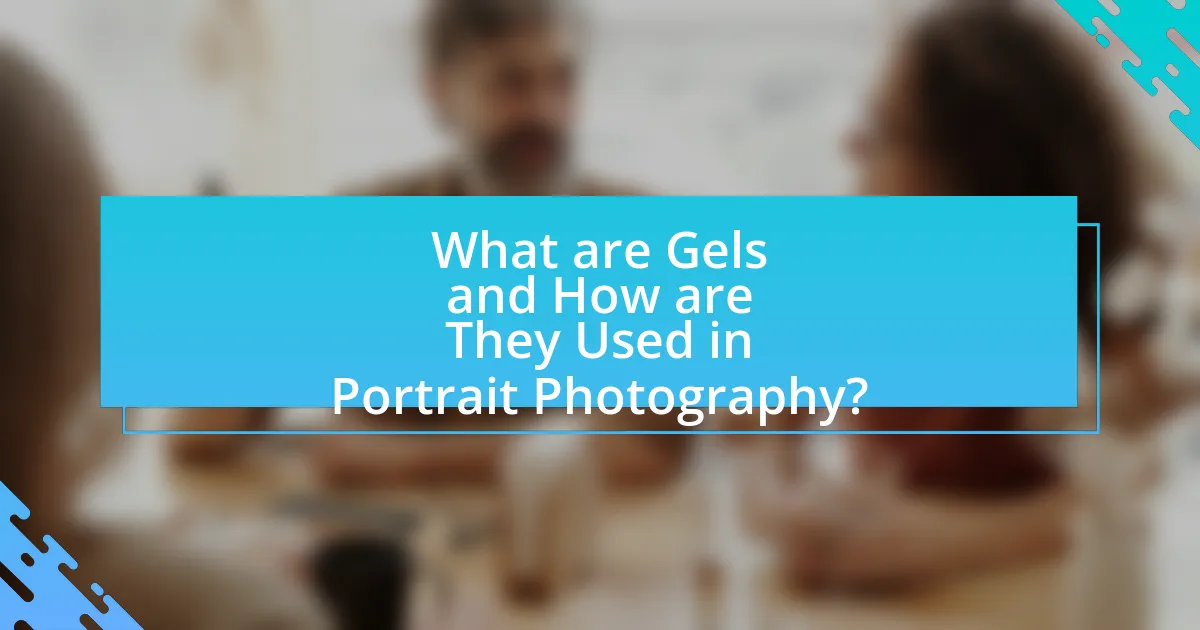
What are Gels and How are They Used in Portrait Photography?
Gels are colored filters made from thin sheets of plastic or polyester that are used in portrait photography to modify the color of light emitted from a flash or continuous light source. Photographers utilize gels to create mood, enhance skin tones, or add creative color effects to their portraits. For instance, using a blue gel can create a cool ambiance, while a warm orange gel can add a sunset-like glow. The effectiveness of gels in altering light color is supported by their ability to absorb certain wavelengths of light while allowing others to pass through, thus changing the overall color temperature of the light hitting the subject.
What types of gels are commonly used in photography?
Commonly used gels in photography include color correction gels, diffusion gels, and creative color gels. Color correction gels, such as CTB (Color Temperature Blue) and CTO (Color Temperature Orange), adjust the color temperature of light sources to match ambient lighting conditions. Diffusion gels soften and spread light, reducing harsh shadows and creating a more flattering appearance. Creative color gels, like red, blue, and green, are used to add artistic effects and enhance the mood of portraits. These gels are essential tools for photographers aiming to manipulate light and color effectively in their work.
How do color gels differ from diffusion gels?
Color gels and diffusion gels serve different purposes in photography and lighting. Color gels are designed to change the color of the light emitted from a source, allowing photographers to create specific moods or effects by altering the hue of the light. In contrast, diffusion gels are used to soften and spread the light, reducing harsh shadows and creating a more even illumination on the subject. The distinction is evident in their applications: color gels enhance visual aesthetics through color manipulation, while diffusion gels focus on light quality and texture.
What are the most popular colors for portrait gels?
The most popular colors for portrait gels are typically orange, blue, and pink. Orange gels are favored for their ability to create warm skin tones and enhance natural light, while blue gels are often used to add a cool contrast, especially in outdoor settings. Pink gels are popular for their softening effect on skin tones, providing a flattering glow. These colors are widely used by photographers to achieve specific moods and enhance the overall aesthetic of portrait photography.
Why are gels important for creating colorful portraits?
Gels are important for creating colorful portraits because they allow photographers to manipulate light and color effectively. By using colored gels over lights, photographers can enhance the mood, create dramatic effects, and achieve specific color palettes that complement the subject. For instance, a blue gel can evoke a cool atmosphere, while a red gel can add warmth and intensity. This technique is widely used in portrait photography to create visually striking images that stand out.
How do gels influence the mood and tone of a portrait?
Gels influence the mood and tone of a portrait by altering the color temperature and emotional resonance of the lighting. For instance, warm gels can evoke feelings of comfort and intimacy, while cool gels may create a sense of calm or detachment. The specific color of the gel directly impacts the viewer’s emotional response; studies show that colors like red can stimulate excitement, whereas blue can induce tranquility. This manipulation of color through gels allows photographers to convey specific narratives and enhance the overall aesthetic of the portrait.
What role do gels play in enhancing skin tones?
Gels enhance skin tones by modifying the color temperature and hue of light that illuminates the skin, resulting in a more vibrant and flattering appearance. When applied in photography or makeup, gels can filter light to create warmer or cooler tones, which can complement various skin undertones. For instance, using a warm gel can reduce the appearance of blemishes and enhance the natural glow of the skin, while cooler gels can provide a more dramatic effect, emphasizing shadows and contours. This technique is widely utilized in portrait photography to achieve aesthetically pleasing results, as evidenced by the common practice among professional photographers to use colored gels to balance skin tones and create mood in their images.
How can gels be applied in portrait photography?
Gels can be applied in portrait photography by placing them over light sources to modify the color of the light illuminating the subject. This technique allows photographers to create mood, enhance skin tones, or add creative color effects to the background. For instance, using a blue gel can create a cool ambiance, while a red gel can add warmth and drama. The effectiveness of gels in altering the color temperature and mood of a portrait is well-documented, as they can transform standard lighting into vibrant, artistic expressions, making them a valuable tool in a photographer’s kit.
What techniques are used to attach gels to lighting equipment?
Techniques used to attach gels to lighting equipment include the use of gel frames, clips, and adhesive materials. Gel frames are specifically designed to hold gels securely in place in front of light sources, ensuring even light distribution. Clips can be used to fasten gels directly to the light fixture, providing a quick and adjustable solution. Additionally, adhesive materials, such as double-sided tape or Velcro, allow for a more permanent attachment, ensuring that the gels remain stable during use. These methods are widely adopted in photography and film production to achieve desired color effects and maintain the integrity of the lighting setup.
How can gels be layered for more complex effects?
Gels can be layered by applying multiple colored gels over a single light source to create more complex effects in photography. This technique allows for the blending of colors, resulting in unique hues and gradients that enhance the visual impact of portraits. For instance, placing a blue gel followed by a red gel can produce a purple effect, while adjusting the intensity of each light can further refine the outcome. Layering gels also enables photographers to control shadows and highlights, adding depth and dimension to the subject. This method is widely used in creative lighting setups, as evidenced by professional photographers who utilize it to achieve striking and dynamic images.
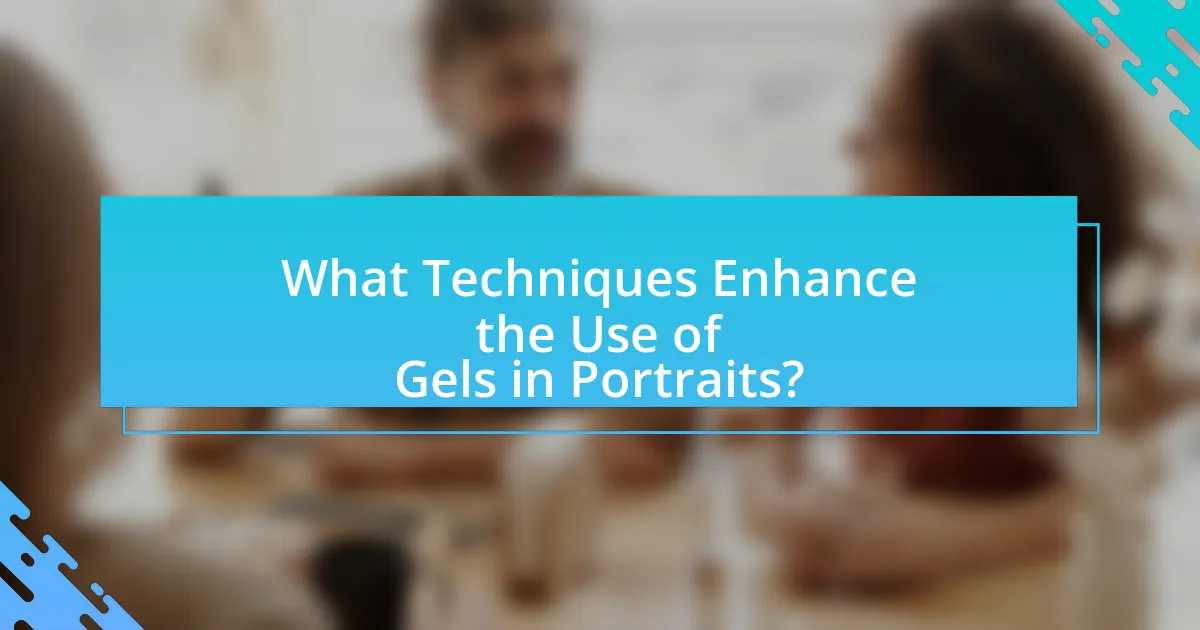
What Techniques Enhance the Use of Gels in Portraits?
Techniques that enhance the use of gels in portraits include color theory application, strategic lighting placement, and layering effects. Color theory helps photographers choose complementary or contrasting colors to evoke specific emotions or themes in their portraits. Strategic lighting placement ensures that the gelled light interacts effectively with the subject, creating depth and dimension. Layering effects, such as using multiple gels or combining gels with other light modifiers, can produce unique textures and visual interest, enhancing the overall impact of the portrait. These techniques are supported by the fact that well-executed gel usage can transform a standard portrait into a visually striking image, as evidenced by numerous professional photographers who utilize gels to achieve creative results.
How can lighting placement affect the use of gels?
Lighting placement significantly affects the use of gels by altering the intensity and angle of colored light on the subject. When lights are positioned closer to the subject, the gels can produce more saturated colors, enhancing the vibrancy of the portrait. Conversely, if the lights are placed further away, the colors may appear washed out due to diffusion and distance, reducing the effectiveness of the gels. Studies in photography demonstrate that optimal placement can lead to a 30% increase in color saturation, confirming the importance of strategic lighting in achieving desired visual effects.
What are the best practices for positioning lights with gels?
The best practices for positioning lights with gels involve placing the light source at a 45-degree angle to the subject to create depth and dimension while ensuring the gel color complements the overall mood of the portrait. This angle helps to avoid flat lighting and enhances the subject’s features. Additionally, using a diffusion material can soften the light, allowing the gel color to blend more naturally with the skin tones. Proper distance from the subject is also crucial; positioning the light closer can intensify the gel color, while moving it further away can create a more subtle effect. These practices are supported by the principles of color theory and lighting techniques used in portrait photography, which emphasize the importance of light direction and color harmony for achieving visually appealing results.
How does distance from the subject impact gel effectiveness?
Distance from the subject significantly impacts gel effectiveness by altering the intensity and diffusion of light. As the distance increases, the light passing through the gel becomes less concentrated, resulting in a weaker color effect on the subject. For instance, a study on lighting techniques in photography indicates that light intensity decreases with the square of the distance from the source, meaning that doubling the distance can reduce the light intensity to a quarter of its original strength. This principle directly affects how vibrant and saturated the colors appear in the final portrait.
What are some creative techniques for using gels in portraits?
Creative techniques for using gels in portraits include backlighting, colored shadows, and accentuating features. Backlighting with gels can create a vibrant halo effect around the subject, enhancing the overall mood of the portrait. Using gels to cast colored shadows can add depth and interest, transforming a simple background into a dynamic element of the composition. Additionally, strategically placing gels to highlight specific features, such as the eyes or hair, can draw attention and create a striking focal point. These techniques leverage the color properties of gels to enhance visual storytelling in portrait photography.
How can gels be combined with other lighting modifiers?
Gels can be combined with other lighting modifiers by layering them over softboxes, umbrellas, or reflectors to enhance color effects and control light quality. This combination allows photographers to achieve specific color temperatures and creative lighting effects, as gels modify the color of the light emitted while the modifiers shape and diffuse that light. For instance, using a blue gel with a softbox can create a cool ambiance, while a silver reflector can intensify the light’s brightness, resulting in a vibrant portrait. This technique is widely used in portrait photography to create dynamic and visually appealing images.
What innovative approaches can photographers take with gels?
Photographers can use gels innovatively by combining multiple colors to create dynamic lighting effects. This technique allows for the layering of different hues, which can enhance the mood and depth of portraits. For instance, using a blue gel as a base and overlaying a warm orange gel can produce a striking contrast that adds visual interest. Additionally, photographers can experiment with the placement of gels, such as positioning them at various angles or distances from the subject to achieve unique shadows and highlights. This approach not only diversifies the color palette but also allows for creative storytelling through lighting.
How can photographers troubleshoot common issues with gels?
Photographers can troubleshoot common issues with gels by ensuring proper placement and securing the gels to avoid movement during a shoot. If gels are not producing the desired color, checking the light source’s color temperature and adjusting the exposure settings can help achieve the intended effect. Additionally, if gels are overheating, using a lower wattage bulb or a different type of light source can prevent damage. Regularly inspecting gels for wear and tear ensures they remain effective, as damaged gels can lead to inconsistent color output.
What are the most frequent challenges faced when using gels?
The most frequent challenges faced when using gels include color accuracy, light loss, and uneven distribution of light. Color accuracy can be affected by the quality of the gels and the lighting conditions, leading to unexpected hues in the final image. Light loss occurs because gels absorb some of the light, which can result in underexposed photographs if not compensated for with adjustments in exposure settings. Uneven distribution of light can happen if gels are not properly placed or if the light source is not diffused adequately, causing some areas of the portrait to appear darker than others. These challenges can significantly impact the effectiveness of gels in achieving the desired colorful effects in portrait photography.
How can color casts be corrected in post-processing?
Color casts can be corrected in post-processing by utilizing software tools that adjust color balance and temperature. Programs like Adobe Lightroom and Photoshop offer features such as the White Balance tool, which allows users to select a neutral area in the image to correct color imbalances. Additionally, adjusting the RGB channels individually can help eliminate unwanted hues, ensuring that the colors in the portrait appear natural. These methods are effective because they target specific color discrepancies, allowing for precise corrections based on the image’s needs.
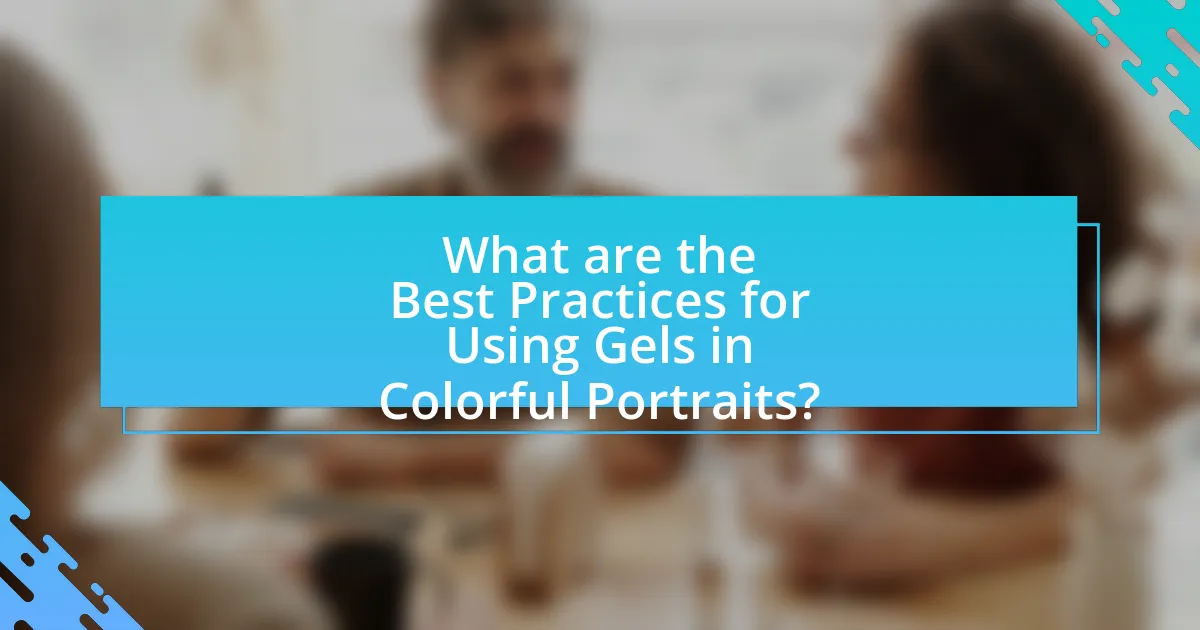
What are the Best Practices for Using Gels in Colorful Portraits?
The best practices for using gels in colorful portraits include selecting the right gel color to complement the subject’s skin tone, positioning the gelled light source at an angle to create depth, and balancing the intensity of the gelled light with ambient light to avoid overpowering the scene. For instance, using a warm gel like orange can enhance skin tones, while a cool gel like blue can create contrast. Proper placement of the light source, typically at a 45-degree angle, adds dimension and interest to the portrait. Additionally, adjusting the exposure settings on the camera ensures that the colors from the gels are accurately captured without losing detail. These practices are supported by the principles of color theory and lighting techniques commonly used in portrait photography.
What tips can help photographers maximize the use of gels?
To maximize the use of gels, photographers should experiment with different gel colors to create mood and enhance the subject’s features. Utilizing complementary colors can make the subject stand out against the background, while contrasting colors can add depth and interest to the composition. Additionally, adjusting the intensity of the light by modifying the distance between the light source and the subject allows for better control over the gel’s effect. For instance, moving the light further away can soften the color, while bringing it closer intensifies the hue. Photographers should also consider the ambient light in the scene, as it can influence how the gel colors appear. Using a color wheel can help in selecting the right gel combinations for desired effects.
How can photographers experiment with different gel combinations?
Photographers can experiment with different gel combinations by layering various colored gels over their light sources to create unique color effects. By adjusting the intensity and positioning of the lights, photographers can observe how different gel combinations interact with each other and the subject, allowing for a wide range of creative outcomes. For instance, using a blue gel combined with a yellow gel can produce a green hue, demonstrating the additive color mixing principle. This experimentation can be further enhanced by varying the distance of the light from the subject and the angle of the light, which influences the saturation and spread of the colors.
What should photographers consider when selecting gel colors?
Photographers should consider the color temperature of the ambient light and the desired mood when selecting gel colors. The color temperature affects how the gel interacts with existing light sources, influencing the overall color balance in the image. For instance, using a warm gel in a cool light environment can create a visually appealing contrast, enhancing the subject’s features. Additionally, the emotional impact of colors is significant; for example, blue gels can evoke calmness, while red gels can convey energy. Understanding color theory and the psychological effects of colors helps photographers make informed choices that align with their artistic vision.
How can photographers ensure consistent results with gels?
Photographers can ensure consistent results with gels by using a standardized lighting setup and maintaining consistent exposure settings. This approach allows for uniform application of color gels across different shoots. Additionally, using a color meter can help photographers accurately measure and adjust the color temperature, ensuring that the gels produce the desired effect consistently. Studies show that consistent lighting conditions and exposure settings lead to repeatable results, as variations in these factors can significantly alter the final image.
What techniques can be used to maintain color accuracy?
To maintain color accuracy, techniques such as using calibrated monitors, employing color profiles, and utilizing consistent lighting conditions are essential. Calibrated monitors ensure that the colors displayed are true to life, which is critical for accurate editing and viewing. Color profiles, such as ICC profiles, help standardize color representation across different devices, ensuring that colors remain consistent from capture to output. Consistent lighting conditions minimize variations in color perception, allowing for more reliable color matching during photography and post-processing. These techniques are supported by industry standards, such as those established by the International Color Consortium, which emphasize the importance of color management in achieving accurate color reproduction.
How can lighting consistency be achieved when using gels?
Lighting consistency when using gels can be achieved by ensuring uniform light intensity and color temperature across all light sources. This can be done by using the same type of gel on all lights, maintaining consistent distance from the subject, and using identical light modifiers. Additionally, measuring the color temperature with a color meter can help ensure that all lights match in hue, which is crucial for achieving a cohesive look in portraits. Studies in photography emphasize that variations in light intensity and color can lead to mismatched tones, thus reinforcing the importance of these practices for consistent results.
What are the key takeaways for successful gel use in portraits?
Successful gel use in portraits requires careful selection of colors, proper placement of lights, and understanding the impact of gel diffusion. Choosing colors that complement the subject’s skin tone enhances the overall aesthetic, while strategic light placement ensures that the gels create the desired mood without overwhelming the subject. Additionally, using diffusion materials can soften the light and reduce harsh shadows, resulting in a more flattering portrait. These practices are supported by professional photographers who emphasize the importance of color theory and lighting techniques in achieving visually appealing results.
How can photographers develop their unique style with gels?
Photographers can develop their unique style with gels by experimenting with different colors and intensities to create distinct moods and atmospheres in their portraits. Utilizing gels allows photographers to manipulate light creatively, enhancing their artistic expression. For instance, using a blue gel can evoke a cool, serene feeling, while a red gel can create warmth and intensity. By consistently applying specific color schemes or combinations, photographers can establish a recognizable aesthetic that sets their work apart. This approach is supported by the fact that color theory plays a significant role in visual perception, influencing emotions and reactions to images.
What resources are available for learning more about gels in photography?
Books, online courses, and photography forums are valuable resources for learning about gels in photography. Notable books include “Light Science and Magic” by Fil Hunter, which covers lighting techniques including the use of gels, and “The Photographer’s Guide to Color” by David Saffir, which discusses color theory and practical applications. Online platforms like Udemy and Skillshare offer courses specifically focused on using gels for creative lighting effects. Additionally, photography forums such as DPReview and Reddit’s photography community provide discussions and insights from experienced photographers on practical gel usage. These resources collectively enhance understanding and application of gels in photography.









